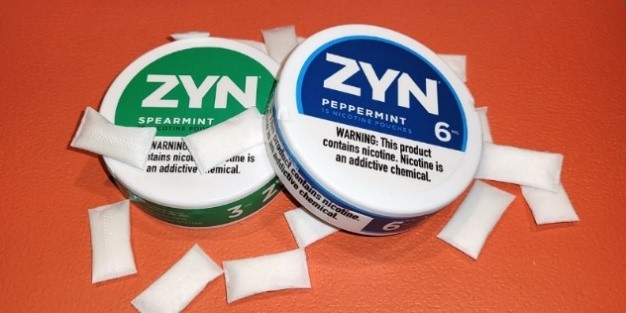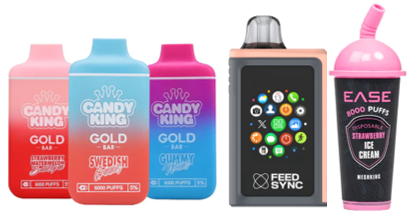TOBACCO-FREE CNY, SEPTEMBER 4, 2024 – With a new school year approaching, there may be more in your child’s backpack than their books and binders. Tobacco companies are continuing to launch new products that are marketed towards youth, and may even look like traditional school supplies. Below is a guide on what new products to look out for, the dangers associated with them, and resources for parents, teachers, and students. Download our fact sheet for quick insights on new tobacco products.
Tobacco and nicotine products are dangerous for young users for a variety of reasons. Their brains are still developing, which may lead them to get addicted to these substances faster, and nicotine use can alter brain development. Although long-term health impacts of vapes and nicotine pouches are mostly unknown, we do know this: they’re not safe. Aerosol from vapes contain many harmful chemicals such as formaldehyde, acetone, benzene, various heavy metals, and a flavoring called diacetyl, which is responsible for a condition known as “popcorn lung”. Additionally, the flavors and high nicotine volumes of these products lead to stronger addictions and are much more enticing for youth. Tobacco companies are continuing to produce new products that are marketed towards youth in an effort to hook another generation on nicotine. Here are some products that you should look out for this coming school year:
Nicotine Pouches (ZYN)
Nicotine pouches, such as the popular brand ZYN, are small pouches filled with nicotine powder. They are placed between the gums and lip to release nicotine, ranging from 3mg to 12.5mg per pouch. They were designed as a “safer” alternative to smoking or using other tobacco products, but their fun flavors, high nicotine content, and concealable nature have led them to become popular among younger people. Although oral nicotine pouches do not contain tobacco, they have their own array of associated health problems. Using oral nicotine pouches can lead to gum disease and recession, gastrointestinal problems and nausea, increased heart rate and other cardiovascular complications, and issues producing dopamine in the brain. For more information on oral nicotine pouches, click HERE.
Vape Advancements
Vapes are slowly becoming multi-functional, high-tech devices that keep the user coming back for more. Many vapes now come with Bluetooth compatibility, allowing users to play their favorite music, text their friends, and even control vape settings through a connected app. Some of these apps are equipped with location tracking of the vape so it is never lost. Other modifications that are being made to vapes include touch screens and games, all in one device. Youth can use their vape to challenge their friends in games and personalize their vapes with their own colored lights and graphics. Some vapes are even designed to look like children’s toys such as action figures and stuffed animals. Vape flavors are used to hook kids. Over 90% of youth who vape are using a flavored product. These flavors include candy, fruit, dessert, mint, and other fun flavors that entice youth.
Vapes Disguised as School Products
![]() Many vapes are designed to resemble school supplies and everyday objects. This is desirable for youth who want to hide their vapes from their parents and teachers. It may be hard to tell what is a vape and what isn’t. Some of the objects that vapes can resemble are pens, highlighters, smart watches, lipsticks, toys, games, and even inhalers. For help on how to spot these devices, click HERE.
Many vapes are designed to resemble school supplies and everyday objects. This is desirable for youth who want to hide their vapes from their parents and teachers. It may be hard to tell what is a vape and what isn’t. Some of the objects that vapes can resemble are pens, highlighters, smart watches, lipsticks, toys, games, and even inhalers. For help on how to spot these devices, click HERE.
Although the vape industry continues to pump out addicting products aimed at youth, there are ways to help students avoid these new products. Parents and teachers can educate students on the harms of using tobacco products and explain how they can avoid peer pressure to use these products. For more information, visit the Tobacco-Free CNY website. Teens in 6th to 12th grade can join Reality Check, a youth engagement program that teaches youth about the manipulative marketing tactics of tobacco companies and empowers them to advocate for change. If you are interested in learning more about Reality Check, visit our website, or email the Reality Check coordinator at CamrynChaffee@ongov.net. For additional resources, follow any of the links below:
More Information
For Parents:
- https://www2.heart.org/site/SPageNavigator/ahc_resources_vapingandecigarettesresource_parent.html
- https://digitalmedia.hhs.gov/tobacco/educator_hub/about/for_parents?locale=en
For Teachers or Administrators:
- https://digitalmedia.hhs.gov/tobacco/educator_hub/about/for_teachers
- https://med.stanford.edu/halpern-felsher-reach-lab/curriculum-data-dashboard.html
- https://www2.heart.org/site/DocServer/AHA_Tobacco-Free_Schools_Toolkit.pdf
For Teens:
